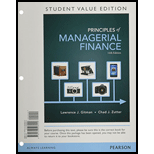
Concept explainers
a)
To discuss:
Required
Introduction:
b)
To discuss:
Required rate of return.
Introduction:
Capital asset pricing model or CAPM establishes the relationship between the projected return for assets and systematic risk on the stocks.
c)
To discuss:
Shift in security market line.
Introduction:
The security market line (SML) is a line, which shows the relationship between the risk, which is measured by beta and the required rate of return for the individual securities.
Want to see the full answer?
Check out a sample textbook solution
Chapter 8 Solutions
Principles of Managerial Finance, Student Value Edition Plus NEW MyLab Finance with Pearson eText -- Access Card Package (14th Edition)

 Intermediate Financial Management (MindTap Course...FinanceISBN:9781337395083Author:Eugene F. Brigham, Phillip R. DavesPublisher:Cengage Learning
Intermediate Financial Management (MindTap Course...FinanceISBN:9781337395083Author:Eugene F. Brigham, Phillip R. DavesPublisher:Cengage Learning

